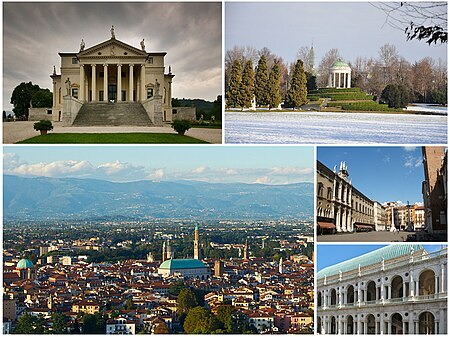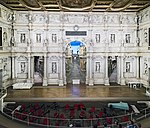Vicenza

Vicenza ( vih-CHENT-sə, Italian: [viˈtʃɛntsa] ; Venetian: Vicensa [viˈtʃeŋ(t)sa]) is a city in northeastern Italy. It is in the Veneto region, at the northern base of the Monte Berico, where it straddles the River Bacchiglione. Vicenza is approximately 60 kilometres (37 mi) west of Venice and 200 kilometres (120 mi) east of Milan. Vicenza is a thriving and cosmopolitan city, with a rich history and culture, and many museums, art galleries, piazzas, villas, churches and elegant Renaissance palazzi. With the Palladian villas of the Veneto in the surrounding area, and his renowned Teatro Olimpico ("Olympic Theater"), the "city of Palladio" has been listed as a UNESCO World Heritage Site since 1994.In December 2008, Vicenza had an estimated population of 115,927 and a metropolitan area of 270,000. Vicenza is the third-largest Italian industrial centre as measured by the value of its exports, and is one of the country's wealthiest cities, in large part due to its textile and steel industries, which employ tens of thousands. Additionally, about one fifth of the country's gold and jewelry is made in Vicenza, greatly contributing to the city's economy. Another important sector is the engineering/computer components industry (Federico Faggin, the microprocessor's co-inventor, was born in Vicenza).
Excerpt from the Wikipedia article Vicenza (License: CC BY-SA 3.0, Authors, Images).Vicenza
Leva' degli Angeli, Vicenza Santa Caterina
Geographical coordinates (GPS) Address Nearby Places Show on map
Geographical coordinates (GPS)
| Latitude | Longitude |
|---|---|
| N 45.55 ° | E 11.55 ° |
Address
Leva' degli Angeli 13
36100 Vicenza, Santa Caterina
Veneto, Italy
Open on Google Maps









